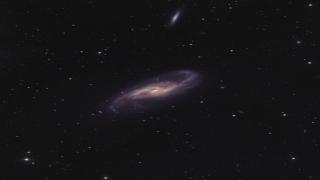Bibcode
Font, Joan; Beckman, John E.; Epinat, Benoît; Dobbs, Clare L.; Querejeta, Miguel
Bibliographical reference
The Astrophysical Journal
Advertised on:
5
2024
Journal
Citations
2
Refereed citations
0
Description
The Whirlpool Galaxy is a well-studied grand design galaxy with two major spiral arms, and a large satellite NGC 5195. The arms both show long uniform sections with perturbations ("kinks" or sharp turns) in specific regions. Comparing the two arms shows a small radial offset between the main kinked regions. We analyzed the morphology and also the velocity field in the disk of M51 using kinematic maps based on Hα and CO line emission. These sample complementary radial ranges, with the CO map covering the central zone and the Hα map extending to cover the outer zone. We looked for indicators of density wave resonance, zones where radial flows of gas in the disk plane reverse their sign. These were present in both velocity maps; their 2D localization placed them along or closely parallel to the spiral arms, at a set of well-defined galactocentric radii, and notably more concentrated along the southern, stronger arm. The results can be well interpreted quantitatively, using a numerical model of the interaction of M51 and NGC 5195 in which the satellite has made two relatively recent passes through the disk plane of M51. During the first pass the pair of dominant spiral arms was stimulated, and during the second pass the strong kinks in both arms were formed at about the same time. The second interaction is particularly well characterized, because the timescale corresponding to the production of the kinks and the recovery of the original pitch angle is identical for the two arms.
Related projects

Spiral Galaxies: Evolution and Consequences
Our small group is well known and respected internationally for our innovative and important work on various aspects of the structure and evolution of nearby spiral galaxies. We primarily use observations at various wavelengths, exploiting synergies that allow us to answer the most pertinent questions relating to what the main properties of
Johan Hendrik
Knapen Koelstra